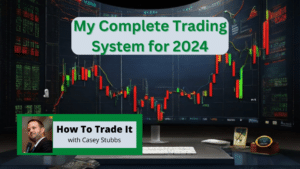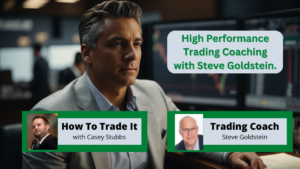How to Track Money Flow with John Seville, Ep #50
What is money flow? How do you use a money flow indicator? Money flow is one of the most useful technical indicators a trader can use. John Seville—the CEO of Acorn Wealth Corp—joins me in this episode of How To Trade It to talk about money flow, volume, risk management, and more. John’s trading journey hasn’t been without challenges but he loves the puzzle of the market and figuring out new ways to continue to make money trading. Don’t miss this insightful episode!
What is money flow? How do you use a money flow indicator? John Seville—the CEO of Acorn Wealth Corp—joins me in this episode of How To Trade It to talk about money flow. Check it out! #stocks #stock #trading #StockMarket #Investing #Invest… Click To Tweet[maxbutton id=”3″][maxbutton id=”4″][maxbutton id=”5″][maxbutton id=”6″]
Subscribe to How To Trade It
You’ll want to hear this episode if you are interested in…
- [1:04] John’s background in trading
- [5:06] How to track money flow
- [8:25] Money flow and volume
- [9:42] What they look for in a flag
- [12:25] Being a trader = solving puzzles
- [18:21] Risk management + planning = success
- [21:56] Avoid emotional decision making
- [24:17] The biggest challenge John had to overcome
- [29:40] How to get FREE access to John’s workshop
How to track money flow
When John first started trading, he used 15 different indicators. Though a multi-indicator trading strategy can be effective, John’s approach was overkill. The further he got into his career, the fewer indicators he used. They used the Twiggs Money Flow Indicator and have since tweaked it to create a money flow indicator for Acorn. It tracks whether or not there’s an accumulation going on behind the charts.
Money flow looks at the underlying things that need to happen. Is the stock expanding in its range? Is volume increasing? These pieces give you the indication that money is accumulating and adding to the position. It’s represented in any easy fashion in the money flow indicator.
You look for money flowing into the stock on pullbacks. For example, SLS went for a big run. They saw the markets were turbulent and SLS was trending down. As that happened, they saw money flow going up. That told them that the price is reflecting that retail traders are selling out. It’s where the smart money is accumulating shares before taking it on a ride. It’s the key thing they look for in a trade.
The relationship between money flow and volume
Money flow tracks volume as part of its calculation. A lot of what you need to know about a stock’s movement is right there in the chart. There are some things where it’s difficult to see the patterns. They use volume indicators to look at individual days. If a stock has broken key resistance, they will look at the volume on that day. Was it 2–3 times the average volume? Where did the volume kick in?
They look for a big breakout with 200% more volume on the one-day versus the 20-day average. The bigger the better. They look for money flow to accumulate and for insider and institutional buying and even looking for high short-flow.
What is the relationship between money flow and volume? The CEO of Acorn Wealth Corp talks about money flow indicators in this episode of How To Trade It! #stocks #stock #trading #StockMarket #Investing #Invest #DayTrading #StockPicks #Money… Click To Tweet*Special offer available ONLY for listeners of the How to Trade it Podcast*
Do you have a financial plan for the future? Investing in stocks may be the answer you are looking for. Dream Trades Monthly Alerts makes it super easy for beginners and removes the guesswork by providing you with a monthly in-depth analysis of a high-profile stock. In the last year, Dream Trades has gotten a 100% return on investment for everyone following the reports. Because you are a listener of the How to Trade It podcast, we are giving you a code for $25 off of a one-year subscription. Check it out at DreamTrades.com (click on “monthly alerts” and use the coupon code: podcast, to get $25 off).
Risk management + planning = success
What does it take to stay profitable for 20+ years? According to John, the #1 thing you need to do is implement a risk management system. You want to make money—but your goal should be to not lose money. You don’t want to allow the money to force you into emotional decision-making.
Secondly, plan your trade and trade your plan. There are trades where the media is hyping up fear and anxiety. You can’t allow yourself to play into it. Look at your stock and your plan. If you ignore the noise, is everything you loved still there? Stick with your plan. Commit to the strategy that you trade. Put blinders on, eliminate noise, and follow your rules.
You have to have a rule system in place because it’s impossible to eliminate emotion. You will always have the fear of loss or the fear of missing out. You must commit to your rules. Do whatever you need to do to keep your rules at the forefront of your mind and stay consistent. You will make mistakes. The rules keep you in the game and help you persevere.
The biggest challenge John had to overcome
John was in Budapest a number of years ago to go to a festival with his girlfriend. The markets opened at 2:30 am. He had a trade he was excited for, so he was rushing through it so they could get going. It was the perfect storm. He accidentally added a zero to the number of shares he was buying and bought $160,000 worth of shares instead of $16,000. To make matters worse, it was triggered accidentally and included pre-market trading. The company released a piece of bad news that sent the stock down 15% within ten minutes after he executed his trade.
He was down $25,000. He hastily exited the trade. As luck would have it, the market opened and the stock went 30% higher. He had sold his long at the bottom in the market. It was all kinds of bad. How can you avoid that? Set defaults and warnings in your brokerage account so you can’t make these kinds of mistakes. Triple-check your orders.
How did he get past it? He had to remember that it was a mistake. It wasn’t because he was a bad trader or made poor choices. As long as you have rules, they are just bumps in the road. You can get back on track. Traders tend to beat themselves up when they have losses. John admits that you must take a breather. Acknowledge the mistake, dismiss it, and go back to your rules.
In this episode of How To Trade It, John Seville—the CEO of Acorn Wealth Corp—shares the biggest mistake he had to overcome in his trading journey. Listen to hear his story! #stocks #stock #trading #StockMarket #Investing #Invest #DayTrading… Click To TweetResources & People Mentioned
- Get FREE access to a complimentary workshop that goes over the smart money indicators they use and how to use them.
Connect with John Seville
- Acorn Wealth Corp
- Connect on LinkedIn
Connect With Casey Stubbs
- Website: https://caseystubbs.com
- YouTube: https://www.youtube.com/TradingStrategyGuides
- YouTube: https://www.youtube.com/caseystubbs
- Twitter: https://www.twitter.com/caseystubbs
- Facebook: https://www.facebook.com/TradingStrategyGuides
- LinkedIn: https://www.linkedin.com/in/caseystubbs/
- Newsletter: https://tradingstrategyguides.ewebinar.com/webinar/live-workshop-learn-the-simple-baseline-strategy-13152
Subscribe to How To Trade It
Disclaimer: Trading carries a high level of risk, and may not be suitable for all investors. Before deciding to invest you should carefully consider your investment objectives, level of experience, and risk appetite. The possibility exists that you could sustain a loss of some or all of your initial investment. Therefore you should not invest money that you cannot afford to lose. You should be aware of all the risks associated with foreign exchange trading, and seek advice from an independent financial advisor if you have any doubts.








